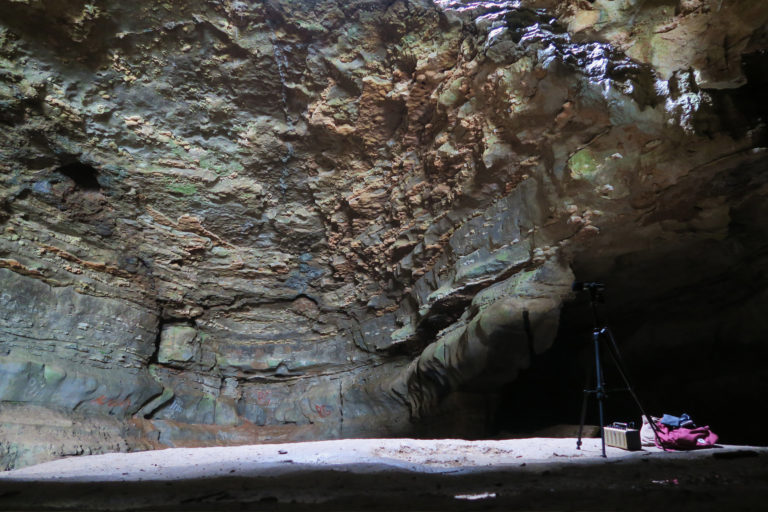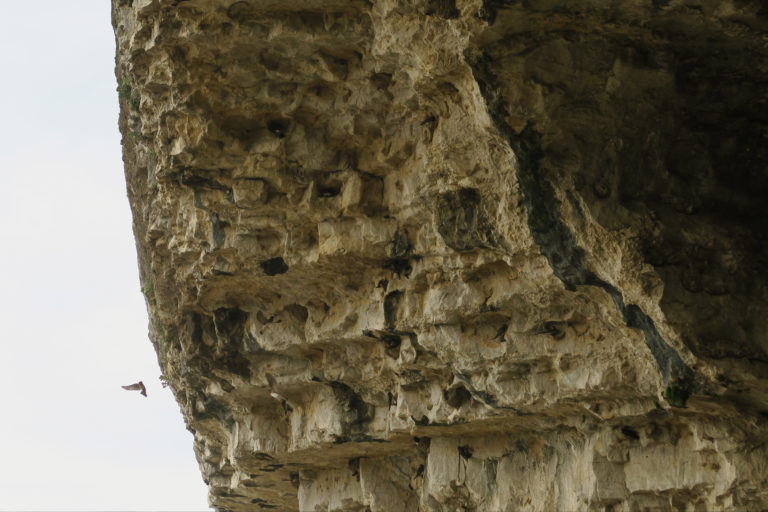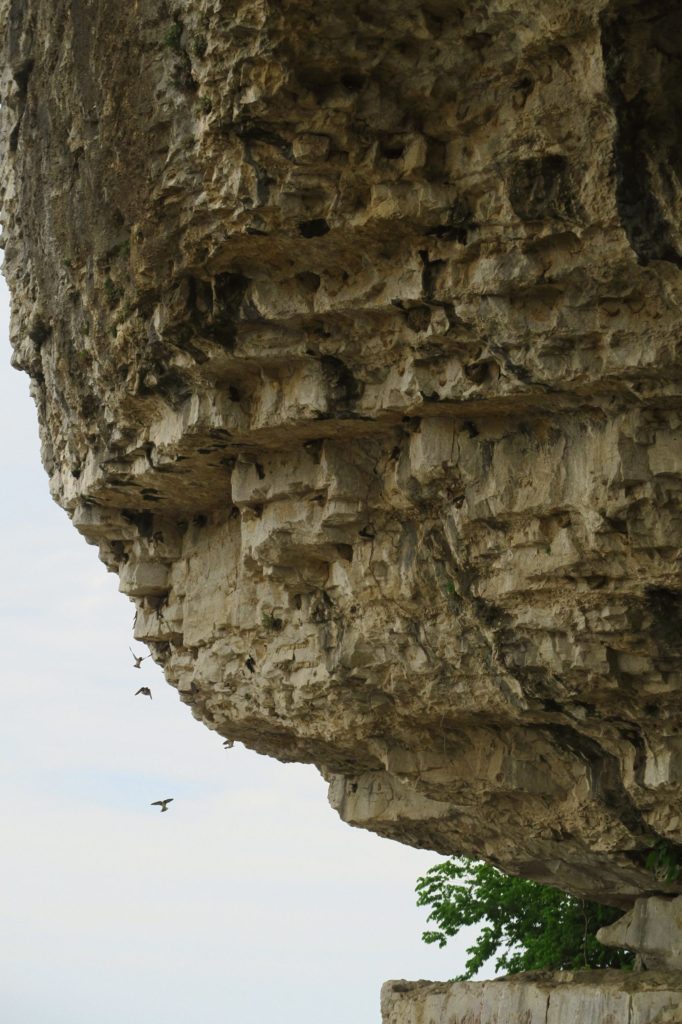SPACE EXTRACT:
CAVE-IN-ROCK
Along the Ohio River, on the south eastern edge of Illinois, sit the town, state park, and cave of Cave-in-Rock. It’s been a goal of mine for some time now to capture a set of impulse responses from this place. I made an initial attempt last spring, but the river was flooded and the cave inaccessible. So this year I returned before the rainy season picked up, recorded some sounds from the cave, took some photos, and captured the impulse responses which are available to download at the bottom of this page.
Cave-in-Rock is a gaping, 55 foot wide, 40 foot tall, 120 foot deep tunnel formed mainly by the slow process of water erosion. Angled in such a way as to only be visible from upstream, and obscured from above by overhanging bluffage, the tunnel is surprisingly well hidden despite its massive opening. Additionally, the cave is large enough to house many people, cool year-round, and has a natural chimney–a crevice above its innermost wall. These all make it a prime spot for people to gather, and it’s perhaps no surprise that the cave became a refuge for river pirates, murderers, counterfeiters, and assorted villains throughout the early decades of the United States’ history.
Among the more nefarious individuals and groups rumored to have spent time in the cave are the James-Younger Gang, notorious river pirate Samuel Mason, and the monstrous Harpe Brothers–America’s first documented serial killers. At one time it operated as a pirate-run tavern and brothel, and the cave was raided on several occasions by both the military and groups of bounty hunters and vigilantes. There is more myth than history tied to the cave though, and, throughout the 19th and early 20th centuries, more than a few pulpy dime novels used the place as a lair for their villains. It was also the location used for the river pirate scene in the classic film How the West was Won.
No doubt that many of the tales are true, though. The stories of Samuel Mason and the Harpe Brothers at least are reliably documented, and are filled with enough horror, betrayal, revenge plots, and poetic turns of fate that you could easily mistake them for fiction. The book The Outlaws of Cave-in-Rock by Otto A. Rothert details their stories in full, and it’s an intensely interesting read.
There’s an extensive record of signatures lining the walls and ceiling of Cave-in-Rock. A collection of carvings and paintings, names and dates that could last centuries, maybe even millennia, until the wind and water finally erase them once and for all. Surprisingly professional looking engravings sit alongside amateurish scratchings and modern, spray painted tags. When the river floods, the more daring among the local vandals will swim into the cave for the chance to scrawl their names across the ceiling. Right at the top of the cave mouth, impossible to miss as you approach, is etched “B.C. Cole 1913” in a sturdy, serifed font. Other engravings at least claim to be from the 17 and 1800’s, and many of them certainly look authentic enough. The date 1886 is just barely visible at the end of the above carving.
When you’re here, it’s easy to see why caves have occupied such a particular role in our myths, religions, and histories. Stories about caves are almost always steeped in mystery at the least, and if they aren’t serving as a hideout for outlaws, chances are they’ll take the role of magical sanctums, the forbidden homes of mystical beasts, or portals to the underworld. They are places where the known world vanishes into darkness, never to be heard from again, and the unknown pours out like a gushing spring. They are also places of immense beauty though, and Cave-in-Rock has been used for more benign communal gathering than the tales would have you believe. Before it was a pirate den, the place was used as a legitimate trading post for decades, and it was used by the Native Americans for centuries before that. By the mid 1810’s it was being used for church services by the inhabitants of the nearby town. A little over a century later, in 1929, the state of Illinois purchased the land surrounding the cave and turned it into a state park, and its history has been relatively peaceful ever since.
I had arrived just after a light rain, and water was dripping everywhere in the cave. This likely introduced a bit of distortion into the impulse responses, but not much judging by the final result. I’ll be making another trip some time during a dryer season to capture some quieter samples. Another source of distortion in this set is from a colony of cliff swallows that have made their homes above the cave entrance. While this was pretty quiet, and I don’t think it made much of an impact on the resulting IR’s, the next trip will also be planned for night time, or the winter, so these chatty residents will either be sleeping or away south for the season.
The cliff swallows are quite something to see, though. They construct little huts out of mud to live in, rather than the usual twig nests that most birds make. You can find them in some urban environments living under bridges. After I was done recording the IR’s, I set the recorder up below their colony and went off to snap some photos of them. They make very strange calls, clicks and creaks that sound sometimes more like a rickety wooden ship than a bird.
Cliff Swallows
Now for it–the impulse responses. These were all recorded using the sine sweep method and are divided into three different sets. I recorded one set using a mid-side microphone setup, and one set using a stereo mic pair. For the mid-side recordings, there’s a set of the raw, unprocessed IR’s, and a set of processed IR’s that have already been decoded from mid-side to left-right stereo. These are good to use as-is with any sound source. If you want to use the raw mid-side set, you’ll need to process your dry stereo sound through a left-right to mid-side encoder first, then send the result to the convolver, and then run your convolved signal through a mid-side to left-right encoder. This will give you a reverb with a very interesting stereo image.
These are all WAV format, 16bit 44kHz. Simply click to download and then unzip to wherever you keep your impule responses.
Cave-in-Rock Mid Side IR’s raw









